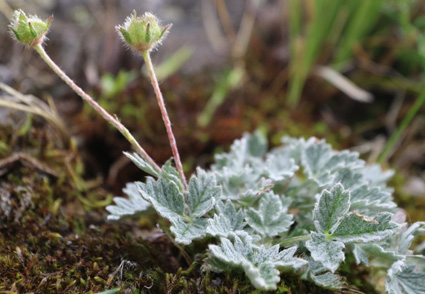Abstract
The genus Potentilla L. is one of the genus with controversial taxonomic position in family Rosaceae, and show a rich species diversity, adapting in mountains hills, high-altitude mountains and arid communities in Palearctic region. Potentilla sanczirii is described and illustrated as new species from Western Mongolian high mountain range. We used conventional morphometric and molecular phylogeny methods to describe new species. With this new contribution, we added a species to the genus Potentilla. L, which makes it with 79 elements in Mongolia. It is morphologically similar to P. nivea, such as, basal leaves ternate, Lower leaflet surface covered with whitish or grayish tomentose. However, differs in multiple caudex covered with dark-brown remains of decayed stipules, and the upper surface of its leaves is adorned with long, silky hairs (light grey). This species' mature nuts (achenes) are light green, approximately 1.0 mm long, and have a smooth surface.A Bayesian Inference tree was reconstructed to further understand the phylogenetic relationships within the genus, and a time-calibrated phylogenetic tree of the subtribe Potentillinae, including 15 species of Pot entilla from Mongolia. The time-calibrated phylogenetic tree suggests that the newly discovered P. sanczirii originated approximately 6.50 million years ago during the late Miocene.
References
- Bouckaert, R., Heled, J., Kühnert, D., Vaughan, T., Wu, C.H., Xie, D. & Drummond, A.J. (2014) BEAST 2: a software platform for Bayesian evolutionary analysis. PLoS computational biology 10 (4): e1003537. https://doi.org/10.1371/journal.pcbi.1003537
- Dobeš, C. & Paule, J. (2010) A comprehensive chloroplast DNA-based phylogeny of Potentilla (Rosaceae) genus: implications for its geographic origin, phylogeography, and generic circumscription. Molecular Phylogenetics and Evolution 56 (1): 156–175.
- Drummond, A.J., Suchard, M.A., Xie, D. & Rambaut, A. (2012) Bayesian phylogenetics with BEAUti and the BEAST 1.7. Molecular biology and evolution 29 (8): 1969–1973. https://doi.org/10.1093/molbev/mss075
- Duman, H. & Mill, R.R. (1999) Two new species of Potentilla L.(Rosaceae) from SW Turkey. Edinburgh Journal of Botany 56 (3): 349–354.
- Eriksson, T., Donoghue, M.J. & Hibbs, M.S. (1998) Phylogenetic analysis of Potentilla using DNA sequences of nuclear ribosomal internal transcribed spacers (ITS), and implications for the classification of Rosoideae (Rosaceae). Plant Systematics and Evolution 211: 155–179.
- Faghir, M.B., Attar, F., Farazmand, A. & Osaloo, S.K. (2014) Phylogeny of the genus Potentilla (Rosaceae) in Iran based on nrDNA ITS and cpDNA trnL-F sequences with a focus on leaf and style characters’ evolution. Turkish Journal of Botany 38 (3): 417–429.
- Feng, T., Moore, M.J., Sun, Y., Meng, A., Chu, H., Li, J. & Wang, H. (2015) A new species of Argentina (Rosaceae, Potentilleae) from Southeast Tibet, concerning the taxonomic status of the genus. Plant systematics and evolution 301: 911–921.
- Gernhard, T. (2008) The conditioned reconstructed process. Journal of Theoretical Biology 253 (4): 769–778. https://doi.org/10.1016/J.JTBI.2008.04.005
- Gubanov, I.A. (1996) Conspectus of flora in Outer Mongolia. Moskva, Valang. [in Russian]
- Gundegmaa, V. (2002) Taxonomy, distribution, ecology and economic importance of Potentilla in Mongolia. Master thesis, Department of Biology, Mongolian National University of Education.
- Gundegmaa, V., Urgamal, M., Sanchir, Ch., Jamsran, Ts., Oyuntsetseg, B. & Nyambayar, D. (2014) Conspectus of the vascular plants of Mongolia. Ulaanbaatar, Mongolia: Admon Printing, pp. 147–152.
- Gundegmaa, V. & Kechaykin, A.A. (2018) A new intersectional hybrid (P. vanzihilii) in the genus Potentilla L. (Rosaceae). Turczaninowia 21 (1): 174–179.
- Grubov, V.I. (1982) Key to the vascular plants of Mongolia (with an atlas). Leningrad, Nauka: 442 pp. [in Russian]
- Kechaykin, A. & Kutsev, M. (2015) Notes on Potentilla L. (Rosaceae) from the Altai. 2. New species from South Siberia and West Mongolia. Feddes Repertorium 126 (3–4): 73–76.
- Kechaykin, A.A. & Shmakov, A.I. (2016) A system of subtribe Potentillinae J. Presl (Rosaceae Juss.). Turczaninowia 19 (4): 114–128.
- Kechaykin, A.A., Shmakov, A.I., Gregor, T., Paule, J. & German, D.A. (2021) (2820) Proposal to conserve the name Potentilla (Rosaceae: Potentilleae) with a conserved type. Taxon 70 (3): 680–681.
- Persson, N.L., Eriksson, T. & Smedmark, J.E. (2020) Complex patterns of reticulate evolution in opportunistic weeds (Potentilla L., Rosaceae), as revealed by low-copy nuclear markers. BMC Evolutionary Biology 20 (1): 1–17.
- POWO (2024) Plants of the World Online. Facilitated by the Royal Botanic Gardens, Kew. Published on the Internet: https://powo.science.kew.org/ (accessed 28 December 2024)
- Shah, M., Sinwari, Z.K., Leghari, M.K. & Nakaike, T. (1992) note the centers of diversity of the genus Potentilla (Rosaceae). Bulletin of the National Science Museum: Series B: Botany 18: 117–122.
- So, S., Jo, H. & Kim, M. (2014) A new species of Potentilla (Rosaceae): P. gageodoensis M. Kim. Korean Journal of Plant Taxonomy 44 (3): 175–177.
- Soják, J. (1987) Notes on Potentilla: IV. Classification of Wolf’s group ‘‘Potentillae trichocarpae”. Candollea 42: 491–500.
- Soják, J. (1994) Notes on Potentilla (Rosaceae) X–XII: X. The section Dumosae XI. The P. microphylla and P. stenophylla groups (sect. Pentaphylloides) XII. Key to the taxa of P. sect. Pentaphylloides (Anserina). Botanische Jahrbucher fur Systematik, Pflanzengeschichte und Pflanzengeographie 116: 11–81.
- Soják, J. (2006) Potentilla gobica (Rosaceae), a remarkable new species from SW Mongolia. Willdenowia 36 (2): 867–869.
- Thompson, J.D., Higgins, D.G. & Gibson, T.J. (1994) CLUSTAL W: Improving the sensitivity of progressive multiple sequence alignment through sequence weighting, position-specific gap penalties and weight matrix choice. Nucleic Acids Research 22: 4673–4680.
- Ulziikhutag, N. (1989) Characteristics of the flora of Mongolia. Ulaanbaatar, Mongolia: State Publishing, pp. 107–148. [in Mongolian]
- Wolf, Th., (1908) Monographie der Gattung Potentilla. Bibliotheca Botanica 71: 1–715.
- Zhao, Y., Lu, D., Han, R., Wang, L. & Qin, P. (2018) The complete chloroplast genome sequence of the shrubby cinquefoil Dasiphora fruticosa (Rosales: Rosaceae). Conservation Genetics Resources 10: 675–678.


